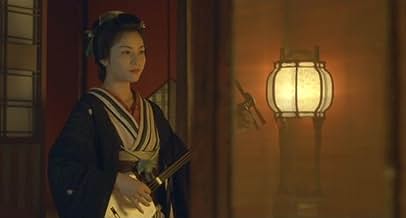Japan, 250 years ago. Soetsu is a moneylender who is killed by the cruel samurai Shinzaemon. His body is dumped in the Kasenega-Fuchi river. According to legend, all who drown in the river w... Read allJapan, 250 years ago. Soetsu is a moneylender who is killed by the cruel samurai Shinzaemon. His body is dumped in the Kasenega-Fuchi river. According to legend, all who drown in the river will never surface again. 20 Years later, Shinkichi, the handsome son of Shinzaemon, coinci... Read allJapan, 250 years ago. Soetsu is a moneylender who is killed by the cruel samurai Shinzaemon. His body is dumped in the Kasenega-Fuchi river. According to legend, all who drown in the river will never surface again. 20 Years later, Shinkichi, the handsome son of Shinzaemon, coincidentally meets Toyoshiga, the daughter of Soetsu. They fall in love. It is a doomed love, ... Read all
- Awards
- 1 win total
- Okou
- (as Reona Hirota)
- Director
- Writers
- All cast & crew
- Production, box office & more at IMDbPro
Storyline
Did you know
- TriviaThough not originally released as part of the J-Horror Theater film series, this film was eventually included as the fifth installment of the anthology. Previous releases include Infection (2004), Premonition (2004), Reincarnation (2006), and Retribution (2007).
- ConnectionsFollowed by The Sylvian Experiments (2010)
The film is a fairly close retelling of Encho Sanyutei's 19th century ghost story entitled "Shinkei Kasane-ga-fuchi" about the cursed fate of two families and the karma passed on from parent to child. Anyone familiar with the 1964 film Kwaidan (the title uses an antiquated spelling of the same word, both meaning "ghost story") will see similarities in the presentation of Nakata's film. Many have said that he intended to pay homage to ghostly films of the 50s and 60s, but that is not going back far enough. The film reflects the very traditions of Japanese ghost stories and fables. The main actor, known for Kabuki, plays opposite a character once played by his own father in a Kabuki performance years earlier.
I stated earlier about the limited view of the horror genre as held by many Western film goers, but it hasn't always been the case. Sadly the idea of a "slow burn" and finding suspense in the thematic fabric of a film is something rare today in Hollywood horror. Too often, films depend on incredibly literal scares, in the form of disturbing images, gore and violence, but lack any real thematic richness. In some ways Nakata's few inserted jump scares in the film made me balk a little. Perhaps it is his Hollywood experience that convinced him that such heavy handedness was needed. The film has some genuinely tense and "Oh .. !" moments (I am sure you know what I mean) that really don't need any audio cues to let us all know they are happening.
Perhaps this is connected to the negativity around this film. For the few scares present in the run time of the story, there aren't much. In fact, categorising the film as "horror" might me somewhat of a misnomer as well, at least by modern Hollywood definition. What we have with Kaidan is a traditional Japanese ghost story and fable that strives to not only thrill us but also impart some wisdom. The true horror of the story is the tragedy inherent in its themes and sheer extent that it spreads. Obviously, what comes along with such a film, some viewers won't like. Viewers expecting something more akin to modern horror films like The Grudge, will no doubt find parts or all of Kaidan boring and uneventful. Others will decry the feature of "more long-haired ghosts" but to be fair, such people don't appreciate the deep tradition of ghost stories in Japan.
White kimonos are what women are cremated or buried in and traditionally all women had very long hair devoid of any colouring or permed curls. I say, if it ain't broke, why try to fix it. Certainly it is better than Hollywood's constant recycling making every second movie monster like the love-child of the Alien and Pumkinhead, or the tendency to laden everything down with CGI and "in case you didn't get it" effects (I am referring to The Ring's, Hollywood equivalent of Sadako).
So whether you'll like this film or not depends on yourself. The film is not a modern horror tale full of scares and jumps. It is a dramatic, period ghost film, drawn from tradition and based on a 19 century novel. If instead of demanding Kaidan to entertain you, open yourself to what it has to tell you. This a story not unlike those told around campfires at night. The scares are in the themes and situations that the characters face and the fear is in those characters' minds. As with many good horror films, the film is out to scare the characters, not you. Get into their heads and you'll feel it too.
- UberNoodle
- Aug 11, 2008
- Permalink
Details
- Release date
- Country of origin
- Official site
- Language
- Also known as
- J-Horror Theater Vol. 5
- Filming locations
- Production companies
- See more company credits at IMDbPro
Box office
- Budget
- $5,000,000 (estimated)
- Gross worldwide
- $3,646,201
- Runtime1 hour 55 minutes
- Color
- Sound mix
- Aspect ratio
- 1.85 : 1
Contribute to this page
























